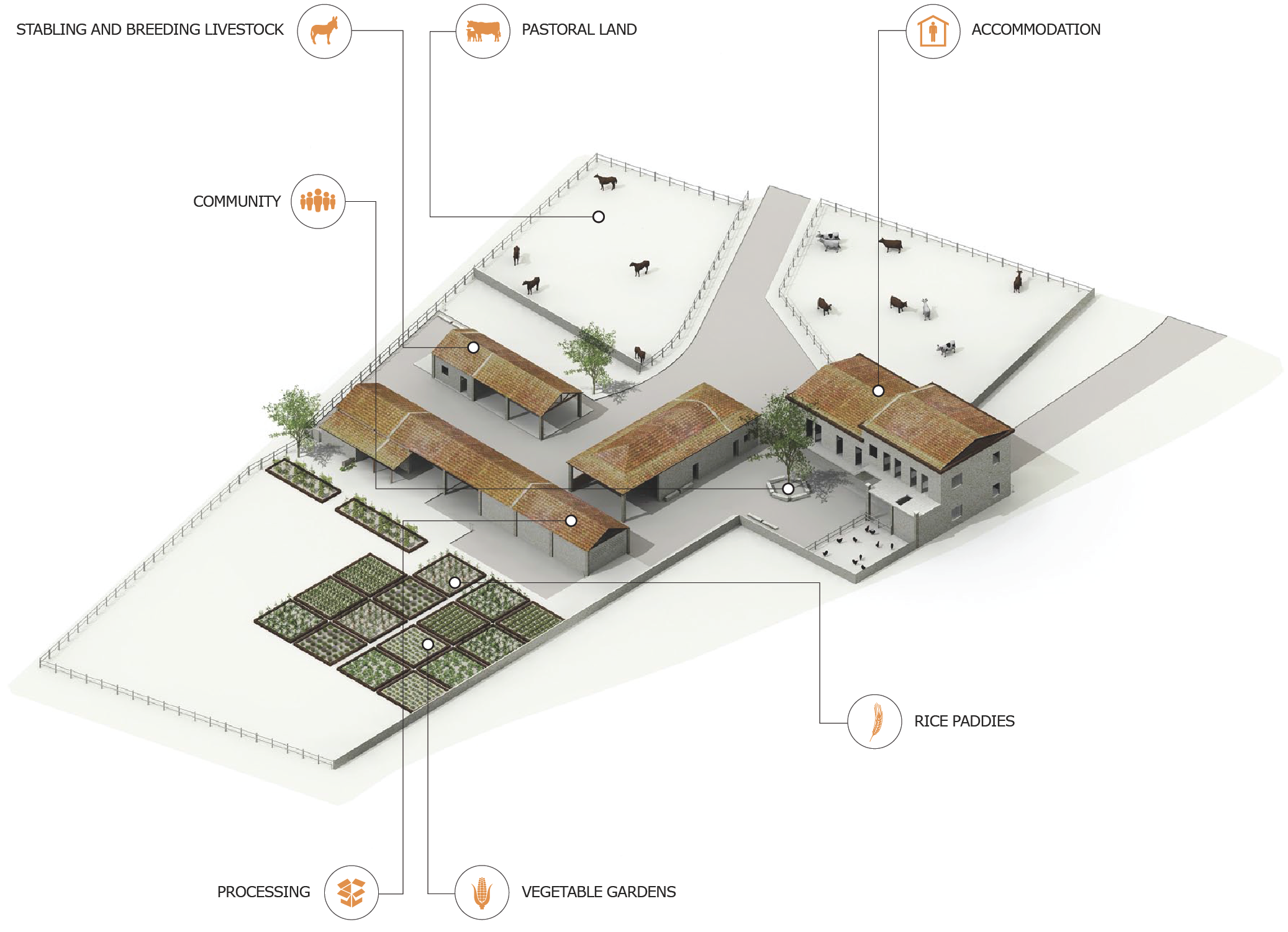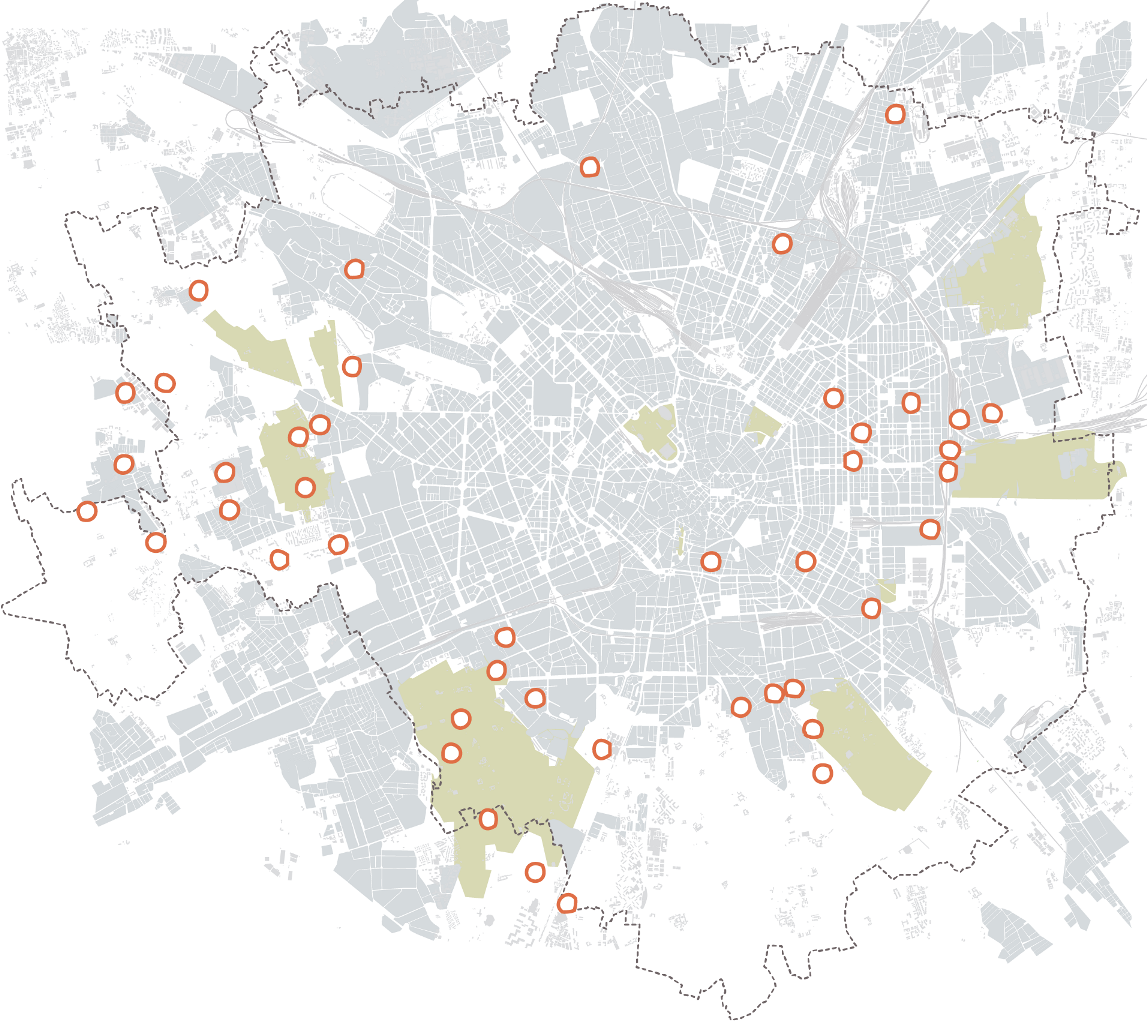The ‘cascine’ or farmhouse complexes, whose remnants can be seen across the peri-urban landscape of Milan today, were the first self-sufficient, rural settlements to have been built in the region, as a means to better govern and manage the territory. Believed to have originated from the monasterial complexes that began to appear across the landscape from around the 6th Century AD, the cascina provided a safe haven for peasants through the medieval ages, when the cities were frequently the focus of invasions coming from all parts of the continent.
Usually owned by wealthy families from the city, or the church (also known as ‘grange’) the complexes that surrounded the large rural homesteads could accommodate anything up to 400 people, most of them workers and their families who were needed to cultivate the land and maintain the complex. Unable to rely upon imports from neighbouring provinces, especially in times
of strife, the cascine were forced to grow their own food, through committing extensive areas to arable and pastoral farming which could extend their primary source of income, and shortly developed themselves into the first important economic centres in Lombardia. At times of conflict, these isolated communities were able to continue to trade unhindered.
In a time where hinterlands were controlled by a selective urban elite, the communes which surrounded Italian cities were managed by city councillors, whose mercantile instincts brought a new perspective to the production and distribution of food for the city.
At a time when agricultural food production in the Milan provincial area was in its heyday, the cascine held dominion over the landscape, not only in terms of economic and social importance, but also in terms of management of the land, control over the water, and care of the earth.

Throughout the middle ages, Milan developed an extraordinarily complex system of waterways, networks of canals and irrigation ditches for the purpose of food production for the city. some of the most advanced in Europe at that time,
In present-day Milan, the detachment of the population from the land could not be more apparent. Consumer lifestyles, hectic work schedules, and availability of cheap food have distanced the population from its agricultural heritage.
When considering how Milan might be able to intensify its current food production methods to meet the demands of the population, it may be more effective to return to a more decentralised form of food production, enabling the more responsible use of natural water sources to intensively cultivate a more diverse range of crop types.
Stabling and Breeding Livestock
With a huge control over the economy and territory, the cascine could afford enormous areas for stabling horses, as well as breeding and rearing livestock for trade. This ensured one of the primary forms of income for the wealthy families that owned the farms.
Community
From the 6th century AD, Christianity had made it’s mark upon the territory of Milan. It was therefore common for cascine complexes to house there own church or chapel, in which all members of the community would attend for service, generating greater bonds of community with the rural populations than in the city.

Pastoral Land
Suggestive of the monopoly that the cascine had over the territory that they controlled, each family would own huge tracts of land upon which livestock could forage and rice could be grown.
Accommodation
Living quarters for anything from 10 to 400 people in times when the harvest was collected. The wealthy family who owned the estate would live upstairs, with servant and worker accommodation housed on the ground floor, and in ancillary buildings.
Processing
The way that the cascine could remain important centres of agriculture and economic affairs in the region was through managing the processing of food from cultivation, right the way through to selling. By housing facilities necessary for the processing of meat and vegetables within the community, the cascine could achieve the distribution of fresh produce, and retain a monopoly over the distribution of food to the city.
Facilities necessary to milking and slaughtering enabled the cascine to process food rapidly, to ensure that it arrived fresh in the city.
Vegetable Gardens
Throughout the medieval period, the cascine of Milan could not rely upon the importation of food from the urban areas, especially Milan, which was frequently the focus of invasions at the time. The rural communities therefore had to adopt all practices of agriculture in order to maintain a constant workforce, and feed the resident families. The cultivation of vegetable gardens usually at the rear of the house yielding buckwheat, beans, potatoes, tomatoes, allowed the communities of the cascine to remain fully self-sufficient, providing an argument for the partial return to traditional practices of living and farming in the modern day Milan.
Rice Paddies
Milan’s location upon a plateau, amidst a dense river network, made it ideal for the growing of rice following the first import of the staple from the Far East. The expansion of rice cultivation, made possible by a transformation of the waterways, and the introduction of advanced water engineering soon projected Lombardia into one of the most intensively-farmed regions in Europe, a title which it still retains today.
The availability of rice to feed the population gave birth to the traditional Milanese dishes of risotto and semolina soups, which set it apart from all other regions in Italy.
The cascine, which became familiar landmarks of ‘La Bassa’ region or ‘the lowlands’, which today covers the Parco Agricolo Sud and the Lodi area, became characteristic of the landscape as a visual connection between the settlement and territory. The gradual decline in power held by the cascine, has slowly severed this connection, as the Milan conurbation becomes ever more dependent upon imports from abroad.

The territory which was formerly controlled and characterised by these farms has undergone profound changes which has gradually decreased the need for this decentralised form of land management, and lessened their influence over the landscape.
That said, the cascine remain some of the only custodians of the vernacular culture of the Milan, in a city which has largely lost its traditions. As the original ‘architects of the transformation of the territory’, the influence of these farms on the landscape is still visible today.

With a need to return to more localised forms of food production in Milan with the ultimate goal of self-sufficiency, it may be useful to examine how a decentralised form of land governance and management became so successful in the past, and how such experiences could be carried forward to the present day.
Follow the links below to explore other similar, related projects